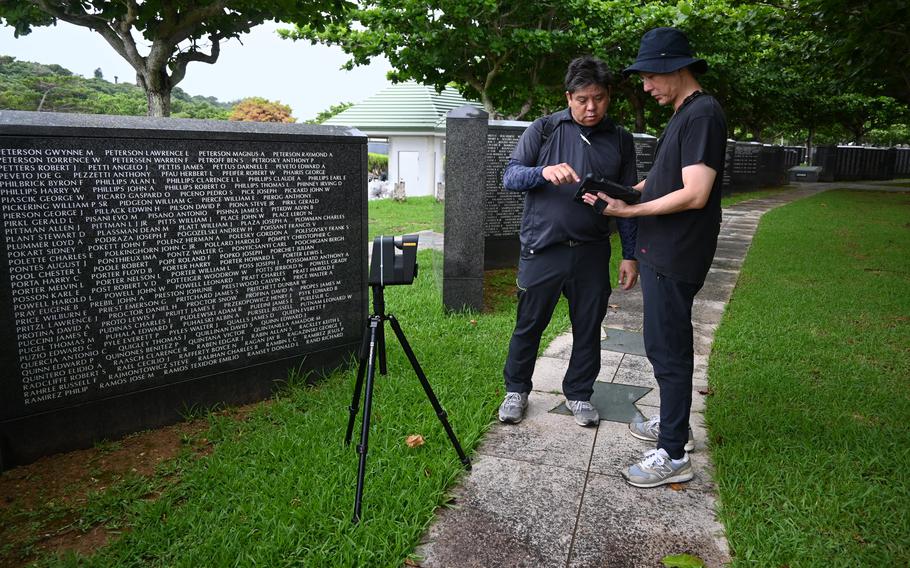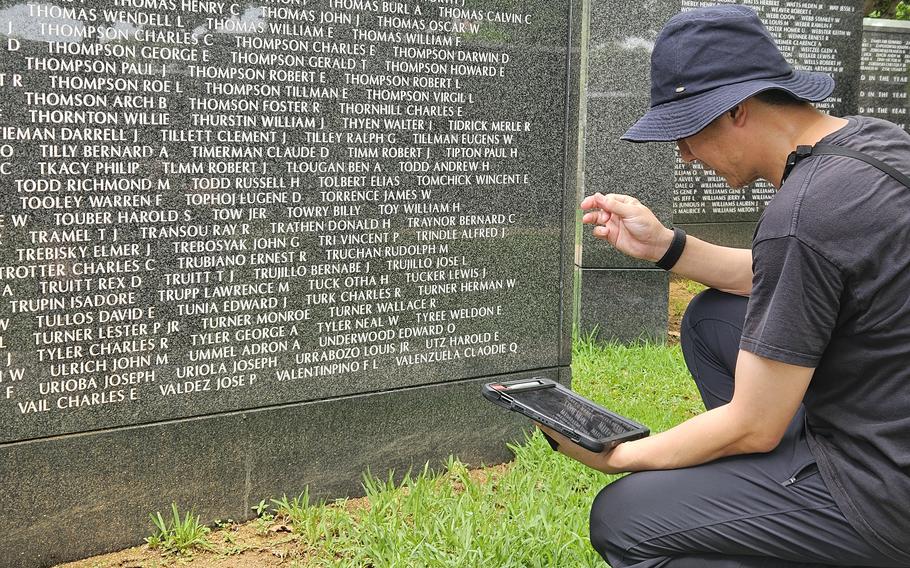Asia-Pacific
Searchable 3D map highlights names of US casualties at WWII Battle of Okinawa
Stars and Stripes August 15, 2025

Ikemiya Shokai Co. Ltd. president Taku Ikemiyagi and sales associate Kaneto Fukuhara check 3D images of names at the Cornerstone of Peace monument at Peace Memorial Park in Itoman city, Okinawa, on July 15, 2025. (Keishi Koja/Stars and Stripes)
ITOMAN CITY, Okinawa — An Okinawa firm has created an interactive website where families of U.S. troops killed during the Battle of Okinawa can see their loved ones’ names on the island’s war memorial.
Ikemiya Shokai Co. Ltd., a printing and scanning company in Naha that specializes in 3D mapping of buildings, launched a website Aug. 1 that features a 3D map of the foreigners’ section of the Cornerstone of Peace at Peace Memorial Park in Itoman. The site allows family members living far from Okinawa to find the names of their fallen relatives.
The memorial park marks the site of the final action of one of World War II’s bloodiest battles.
More than 14,000 Americans, about 110,000 Japanese troops and at least 140,000 Okinawan civilians died during or immediately after the Battle of Okinawa.
The 80th anniversary of the battle was observed June 23 at a ceremony at the park.
The Cornerstone of Peace, built 50 years after the battle, displays the names of nearly 250,000 who died during the fighting: 14,011 Americans and 227,977 Japanese. The foreigners’ section includes the American names and another 579 names from Britain, North and South Korea and Taiwan.
With the 80th anniversary of the war’s end this year, the timing seemed right to launch the website, Ikemiya president Taku Ikemiyagi said June 18 at the company’s office.

Taku Ikemiyagi, president of Ikemiya Shokai Co. Ltd., checks 3D images of the Cornerstone of Peace monument at Peace Memorial Park in Itoman city, Okinawa, on July 15, 2025. (Brian McElhiney/Stars and Stripes)
The map, which can be found at okinawapeacememorial-3dmap.org, is searchable by name. The website also includes an English translation of the purpose of the Cornerstone of Peace, which greets visitors at the entrance.
“The purpose of the Cornerstone of Peace is to pray for all the war dead, no matter if they were enemies or allies,” Ikemiyagi said. “That’s one of the reasons why we focused on the foreigner’s side.”
Ikemiyagi and his sales associate Kaneto Fukuhara came up with the idea for the website in 2023. A chance encounter while they were taking test shots at the park inspired them to move forward.
“An American family asked us what we were doing, and we told them about the project,” Fukuhara said. “They really liked it and showed enthusiasm, and we thought that this might be a good idea.”
The two took 143 pictures at the monument to create the map during an eight-hour session on May 15.
They created their own database of names from the photographs after being unable to obtain the list from the prefecture. They said they plan to update the website every five years with any new names that are added.
Ikemiyagi said he hopes that people from other countries will learn about the memorial and its significance through the site. It could also help families add to the memorial the names of relatives killed in the battle.
Navy Master Chief Petty Officer Doug Rocks, whose great uncle, Marine Pvt. William George Rocks, died of his wounds during the battle, said he was surprised to discover his great uncle isn’t listed on the memorial.
William Rocks, of H Company, 3rd Battalion, 29th Regiment in the 6th Marine Division, was shot by a Japanese sniper in his right thigh on May 12, 1945, Doug Rocks said. He died at a field hospital on Guam 13 days later, according to his casualty report.
“I guess all the brothers and sisters took it pretty hard, and they really didn’t talk about him,” Rocks, who serves with Naval Air Forces Atlantic in Norfolk, Va., said by phone July 16. “I didn’t even really know he even existed until after I joined.”